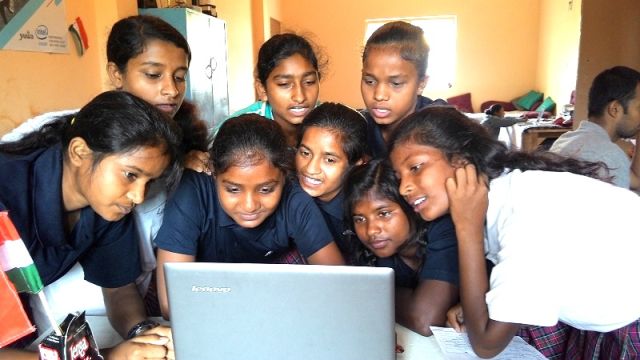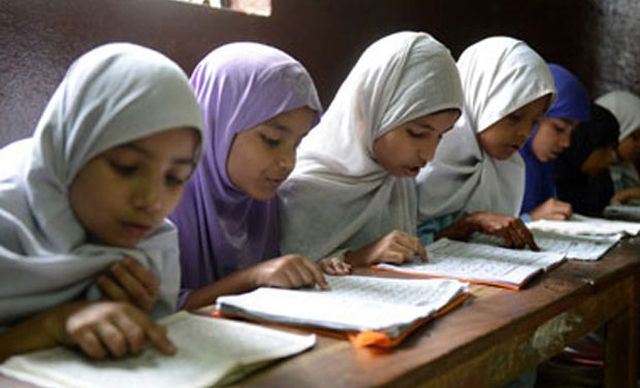
by admin | May 25, 2021 | Muslim World
 London : Apple on Monday announced to support The Malala Fund — led by Nobel Peace Prize Laureate Malala Yousafzai — which is focused on advocating every girl’s right to 12 years of free, safe and quality education.
London : Apple on Monday announced to support The Malala Fund — led by Nobel Peace Prize Laureate Malala Yousafzai — which is focused on advocating every girl’s right to 12 years of free, safe and quality education.
Apple will become the fund’s first Laureate partner, enabling a significant expansion of Malala’s effort to support girls’ education and advocate for equal opportunity.
“We believe that education is a great equalising force, and we share Malala Fund’s commitment to give every girl an opportunity to go to school,” CEO Tim Cook said in a statement.
Cook will also join the Malala Fund leadership council.
“Yousafzai is a courageous advocate for equality. She’s one of the most inspiring figures of our time, and we are honoured to help her extend the important work she is doing to empower girls around the world,” Cook added.
With Apple’s support, Malala Fund expects to double the number of grants awarded by its “Gulmakai Network” and extend funding programmes to India and Latin America — with the initial goal of extending secondary education opportunities to more than 100,000 girls.
The fund’s “Gulmakai Network” currently supports programmes in Afghanistan, Pakistan, Lebanon, Turkey and Nigeria.
Apple will help Malala Fund scale its organisation by assisting with technology, curriculum and research into policy changes needed to help girls everywhere attend school and complete their education.
“My dream is for every girl to choose her own future,” said Yousafzai.
“I am grateful that Apple knows the value of investing in girls and is joining Malala Fund in the fight to ensure all girls can learn and lead without fear,” she noted.
Since 2013, Malala Fund has been working in partnership with other organisations, the private sector and governments around the world to realize every girl’s right to 12 years of free, safe, quality education.
“With an estimated 130 million girls out of school, the importance of their work is increasingly essential,” Apple said.
—IANS

by admin | May 25, 2021 | Opinions

For representational purpose only (google image)
By Swagata Yadavar,
If a girl in India studies for 12 years or more — till the age of 18 — she is less likely to have teenage pregnancy, less likely to have shorter interval between children and less likely to have more than two children during her lifetime, according to the latest national health data.
A woman with 12 years or more of education has her first child at the median age of 24.7, which is 3.7 years more than the median age of first pregnancy (21) for women between 25-49 years, according to the National Family Health Survey, 2015-16 (NFHS-4) report.
Almost one-third or 33.6 per cent of India’s population is born of adolescent pregnancies; delaying the onset of child bearing could reduce India’s projected 2050 population of 1.7 billion by more than a quarter.
If a woman studies for 12 years or more, she has an average of 2.01 children, compared to 2.2 for all women and 3.82 for women with no education, based on the mean number of children born to women aged 45-49 — a period that marks the end of a woman’s fertility.
“Postponing first births and extending the interval between births have played a role in reducing fertility in many countries,” said the NFHS-4 report.
The total fertility rate for women — the number of children she will have in a lifetime — between 15-49 years is even lower at 1.71 for women with more than 12 years of education compared with 3.06 to women with no education and 2.2 for all women.
“Education is the best contraceptive pill,” said Poonam Muttreja, executive director, Population Foundation of India, an advocacy working on family planning.
There is enough global evidence showing that educating women can reduce the fertility rate of countries, Muttreja said. “Now, national evidence also points that educating women can be a good population control strategy.”
Only four per cent of women with 12 years or more of education have teenage pregnancies compared with eight per cent for all women and 20 per cent for women with no schooling.
Child bearing at a very young age is associated with increased risk of complications during pregnancy and childbirth and higher rates of neonatal mortality.
Children born to educated mothers have higher chances of survival; under five mortality — deaths per 1,000 live births of children under five — of children whose mothers had no schooling was 67.5 while it was less than half (26.5) for children of mothers who had more than 12 years of schooling.
A woman with more than 12 years of education waits three years (35.7 months) to have another child, compared to 31.3 months for women with no schooling.
Birth intervals of less than 24 months can harm newborns and their mothers, causing preterm births, low birth weight and death.
Only 21.5 per cent women aged 15-49 had studied for more than 12 years, compared to 29.6 per cent of men.
In 2017, only one in five adolescents — 14 to 18 years — had completed eight years of schooling and by 18, some 32 per cent females are not enrolled in schools against 28 per cent males, according to the latest Annual Survey of Education Report.
(In arrangement with IndiaSpend.org, a data-driven, non-profit, public interest journalism platform, with whom Swagata Yadavar is principal correspondent. The views expressed are those of IndiaSpend. Feedback at respond@indiaspend.org)
—IANS

by admin | May 25, 2021 | News

for representational purpose only (google search)
By Saket Suman,
New Delhi : About a decade ago, when Latika Gupta began her teaching career at a reputed Delhi University college, she became curious about “the interplay of religion and gender in the lives of girls” and thus set out on a journey to explore this rather untouched facet. The result? Her just-released book, “Education, Poverty and Gender: Schooling Muslim Girls in India”, focuses on how the academic life of its students is affected by their religion and culture by examining the interplay between “home” and “school”.
Gupta, now an Assistant Professor at the University’s Central Institute of Education, was then teaching a course which offered opportunities to young girls to reflect on their own socialisation. Barring one or two of her students, she noticed among the rest an attitude of indifference towards their individual development and determination to adhere to the cultural norms.
“I often wondered why my students did not feel embarrassed when they missed classes on account of their participation in religious rituals at home or for household chores. What stopped them from developing a sense of stake in themselves and investing more energy in their education? It became my personal agenda to locate the forces which shape girls’ life and self-identity,” Gupta told IANS in an interview.
Her book attempts to explore the intertwining between the religio-cultural framework of a community and life at school. The study also serves as a means of grasping the complex phenomenology of the educational experience of Muslim girls growing up in a lower socio-economic setting. It identifies the milieux which are formed when religion and gender combine to make a social force in a specific socio-economic context.
Gupta studied the identity of girls enrolled at a minority school, which is governed by the provisions of Articles 29 and 30 of the constitution that allow religious minorities to run their own educational institutions to preserve and promote their culture, language and faith.
She said that she gathered the life experiences of girls studying at the school with the help of free-hand narratives they wrote about their life and aspirations and their responses to items about different dimensions of identity. She then hermeneutically situated their narratives and responses in their everyday ethos which she accessed by experiencing it consistently over a period of one year and by interviewing their parents.
“The school does not interfere in their gendering and thus does not break the sharp binary of home-outside in the life of girls. It does not enable its learners to develop their potential to avail opportunities for economic and intellectual growth in later life. In fact, it certifies the community’s model by not serving as an intellectual space and encouragement for rational inquiry on what one sees around and for critical reflection on one’s own life experiences,” she maintained.
Gupta’s book is based on a study carried out in a school in Daryaganj. However, throughout the book, the school is referred to simply as MGS (Muslim Girls School) in order to maintain its privacy.
“For Muslim girls, there is continuity between home and school in appreciable values and behaviour. There is no alternative frame of conduct available to Muslim girls of Daryaganj. What they learn at home is consistent with what they learn at school as far as personal conduct is concerned. In a matter of immediate and intimate significance, the teacher and the mother provide similar values even though the former is educated and professionally qualified.
“In the life of MGS girls, the school figures in the middle of well-established traits of gender socialisation and a pre-destined as well as explicitly articulated purpose of female life. The cushioning from both sides leaves a very narrow space for the school to allow and encourage any critical engagement with the various fields of knowledge and their own life experiences. Nevertheless, most of the girls have an informed and tolerant outlook towards Hindus, and a few of them have the potential of evolving into a tolerant individual. By asserting their aspiration to study beyond school and thereby becoming teachers, some of them have stretched the discourse of the community slightly which otherwise maintains a predetermined purpose for the life of girls. However, the number of such girls is very limited,” she contended.
Gupta also mentioned that the girls of the given school consider it “important for a wife” to serve her in-laws, husband and children; and from the husband they expect a smooth financial provision and fulfillment of needs. No girl, she said, considers it viable for a woman to be a good wife to contribute financially to the family’s maintenance. “Apparently, they have internalised the gendered male-female division in all spheres of activities. My respondents have accepted and internalised the model of dependence on the man for fulfilling all kinds of needs. The girls thought that motherhood is the aim of a woman’s life,” she recalled.
(Saket Suman can be contacted at saket.s@ians.in)
—IANS

 London : Apple on Monday announced to support The Malala Fund — led by Nobel Peace Prize Laureate Malala Yousafzai — which is focused on advocating every girl’s right to 12 years of free, safe and quality education.
London : Apple on Monday announced to support The Malala Fund — led by Nobel Peace Prize Laureate Malala Yousafzai — which is focused on advocating every girl’s right to 12 years of free, safe and quality education.

